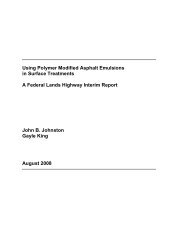Spray Applied Polymer Surface Seals - TSP2
Spray Applied Polymer Surface Seals - TSP2
Spray Applied Polymer Surface Seals - TSP2
Create successful ePaper yourself
Turn your PDF publications into a flip-book with our unique Google optimized e-Paper software.
Lessons Learned<br />
Fog Seal<br />
When to Use?<br />
Pavement Age<br />
• Seal newer pavements<br />
• Rejuvenate age-embrittled pavements<br />
Permeability Enables Infiltration<br />
• Mix design (coarse, fine, open, SMA)<br />
• Construction density<br />
• Densification under traffic<br />
When to Use Fog and Rejuvenator <strong>Seals</strong><br />
One goal of the study is to determine the timing of sealing applications. The DOT survey showed<br />
that many agencies have a scheduled fog seal application program for preventive maintenance that<br />
begins between two and ten years after HMA construction, and some routinely use spray applied<br />
seals immediately after chip sealing.<br />
Observations of four-year old seals in this study showed that most materials exhibited minimal visible<br />
color difference between sealed and control sections because most asphalt residue had worn off of<br />
the surface aggregate. However, the water, raveling and cracking protection still appeared to be<br />
intact. While the most accurate approach would be a test parameter for determining when to reseal,<br />
the required testing is not practical for most agencies. Once aging models and product performance<br />
criteria are understood, it should not be difficult to establish timing models that require minimal testing<br />
for verification. A scheduled interval based on the climate, traffic and surface type of "every x years<br />
or observation of minor distress, whichever comes first" may be the best strategy. Possible triggers<br />
for sealing or resealing might include: very small surface cracks, permeability above a specified<br />
level, raveling, loss of fines or mastic from the surface, or rheological (DSR and/or BBR) tests<br />
indicating excessive age hardening. Older conventional wisdom suggests that surface pitting and<br />
raveling begins when binder ductility measured at 15ºC falls below 10 cm, and block cracking begins<br />
when the ductility reaches 5 cm.<br />
Even if a simple timing approach is adopted, pavement permeability will remain a critical variable. If<br />
emulsions do not infiltrate into the surface, friction may be a problem and performance will not be<br />
satisfactory, resulting in accidents and potential disuse of spray applied seals. Field or lab<br />
permeability tests, infiltration tests such at the ring test (12), pour tests, or short trial sections on the<br />
pavement may be used. A more aggressive alternative might be a performance test for friction upon<br />
release to traffic or following a prescribed curing period, preferably based on a pre-project test strip.<br />
Caltrans recently funded research to be led by Dr. Gary Hicks at the regional Pavement Preservation<br />
Technical Center at Chico State which will deliver a performance specification for fog seals, including<br />
friction requirements.<br />
54
















